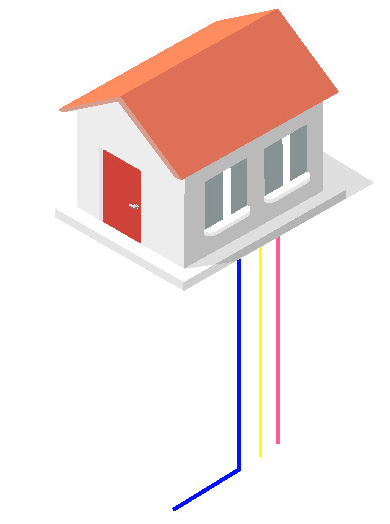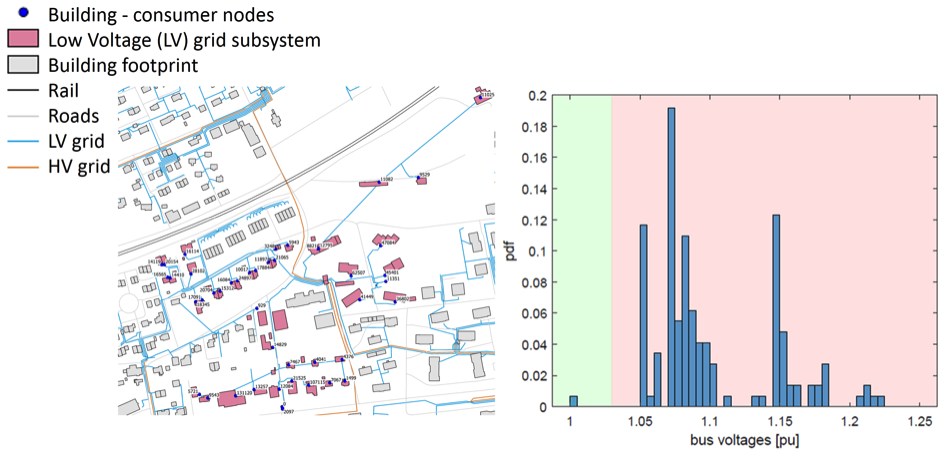Aim
 |
Provide DSOs with tools for the planning of energy hubs in order to improve the efficiency of the systems. |
Activities
Flexibilisation potential of electricity demand
The objective of optimal planning of distributed generation and ancillary services requires modelling the multi-energy consumption and grids. The first step is to gather all required data from building to grid for selected LV grid and assess missing or unavailable data. Then an analysis at the low voltage grid scale of the bottlenecks to high penetration of distributed generation is performed. Finally the planning and operation of the ancillary services can be optimized.
Design of sizes for batteries, heat storage, fuel cells or heat pumps as a function of the evolution of the grid
A tool has been developed to compile heterogenic information of the built environment at the levels of the buildings and the districts and gathered on the RE demonstration site (Bloch et al, 2017) therefore providing a basis for a generalization of the approach at the Swiss scale. Based on this information, a model for the optimal selection and operation of the energy conversion technologies in and on the buildings has been used to generate and evaluate optimal scenarios aggregated at the scale of neighborhoods bounded by the LV grid. The scenarios are given in the form of Pareto curves giving the trends between capital and operating expenses, total renewable energy penetration and CO2 emissions as a function the technology portfolio.
Preliminary Results
Flexibilisation potential of electricity demand
Using grid topology and buildings data, a multi-energy assessment of the 36 low voltage grids of Rolle has been conducted based on criteria such as building age, heating system or PV potential. Then a ranking system based on the criteria used for the assessment allowed us to select one representative low voltage grid and start a more detail study. The low voltage grid (TR3716) has been selected and modelled. Missing or unknown data (such as the load curves at each node) has been estimated from the yearly consumption and measurements of similar consumers (using data from other projects).
Some preliminary results of power flow simulation including PV generation on every roof, show that the existing electrical grid is a bottleneck to high PV penetration. Flexibilisation of the electricity consumption is being considered to see how the help relax the bottlenecks. For this evaluation data gathered from the Flexi project (carried out on the DSO La Goule) for households are used. They should be shortly complemented with data estimated for other types of consumers. The additional flexibilisation potential offered by building and water heating will also be taken into account. The trade-off between investment and renewable energy share of the energy consumption has already been evaluated with Pareto curve at the building and grid level.
Design of sizes for batteries, heat storage, fuel cells or heat pumps as a function of the evolution of the grid
Preliminary results (Stadler et al, 2017a) shows that with efficient investment strategy at building scale, the capital expenditures reduce after reaching the maximum PV utilization (hosting capacity) and reaches a point where the storage capacity is increased, thus improving the self-energy consumption.
At district scale, replacement of purely fossil-based boilers by heat pumps (HP) increase the grid peak demand by 208% and the grid consumption by 135%. Indeed, the renovation of building reduce the sizes of HP by a third, moreover the integration of PV reduces the peak power. The integration of PV phase out thermal panels, topping grid peak demand by 150%.
The extrapolation at national level (Stadler et al, 2017b) shows that efficient investment strategy in terms of CO2 emission reduction phase out the boilers before renovation and PV installation actions. An investment of 19 billion CHF/yr could decrease CO2 emissions by a factor 5.
On-going work focuses at the micro-grid scale or district scale on the combined use of optimal energy technology integration models and grid flow-resulting from solar-energy conversion and electrical grid constraints (Figure 1).

Figure 1: Maximum PV penetration impact on the grid voltage without model predictive control (MPC)
During the following years of the SCCER-FURIES REel project, further research developments will focus on flexibility assessment at the district scale taking into account smart multi-energy building systems and prosumer activities. Furthermore, optimizations focused on grid impact of multi-energy systems for the preselected scenarios will be carried out. Besides, the planning at different time horizon will be considered, including insights from stakeholders to take into account market variations and thus enforce the holistic vision (Schüler et al, 2017) of the project.
Involved partners/Contacts
 |
Grid Integration: Dr. Luc Girardi (EPFL-IPESE) PV potentials: Dr. Nicolas Wuersch (EPFL-PVLab) |
References
Bloch, L., Holweger, J., Wyrsch, N., Tommasi, H. and Girardin, L. (2017) SCCER JA-RED D1.2.1 Report: Development of Future District Scenarios and Definition of Modeling Cases, December 2017
Schüler, N., Cajot, S., Peter, M., Page, J. and Maréchal, F. (2017) The optimum is not the goal: Capturing the decision space for the planning of new neighborhoods, submitted to Frontiers in Built Environment – Urban Science, 2017 https://infoscience.epfl.ch/record/228881?ln=en
Stadler, P., Girardin, L., Ashouri, A., and Maréchal, F. (2017) Contribution of model predictive control in the integration of renewable energy sources within the built environment, submitted to Frontiers in Energy Research, December 2017 https://www.frontiersin.org/articles/10.3389/fenrg.2018.00022/abstract
Stadler, P., Girardin, L., and Maréchal, F. (2017) The Swiss Potential of Model Predictive Control for Building Energy Systems, In: The 7th IEEE International Conference on Innovative Smart Grid Technologies (ISGT Europe), Turin, 2017. http://ieeexplore.ieee.org/stamp/stamp.jsp?arnumber=8260100